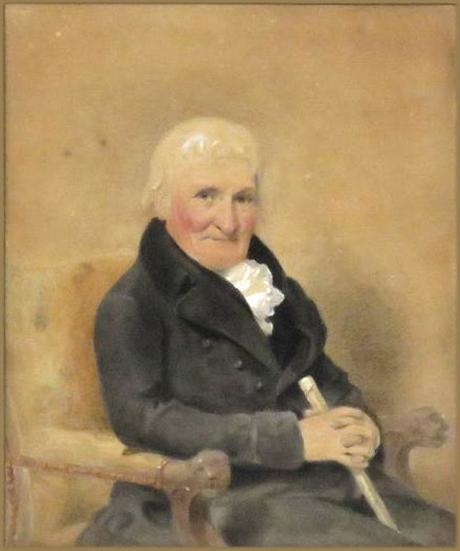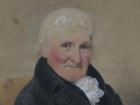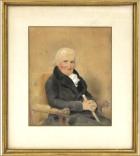on the reverse " Mr Peacock/Architect/by/Mr Nicholson R.S.A"
Peacock, James (1735/1738–1814), architect and surveyor, was for over forty years assistant clerk of works to the City of London. Nothing is known of his early life, although, according to Sir John Soane, Peacock became acquainted with George Dance the younger soon after Dance's return from Italy in December 1764. From then on the two formed a professional alliance which remained uninterrupted until Peacock's death; their abilities were complementary, with Peacock supplying the skills of surveying and estimating to Dance's abilities as a designer.
In December 1771 Peacock was appointed assistant to Dance, who had succeeded his father as clerk of works to the City of London in 1768, on Dance's recommendation and at his expense, although this arrangement was altered in 1776, when Peacock was given a salary by the corporation of £52 10s. He was also employed by Dance in his private practice. Peacock's only independent work of importance was the stock exchange in Capel Court, which was built to his designs in 1801–2 but reconstructed by Thomas Allason in 1853–4. He also carried out repairs to St Anne and St Agnes, Gresham Street, in 1781–2, and to St Stephen Walbrook in 1803–4.
More remarkable than his architectural works was Peacock's prolific output as an architectural theorist, an inventor, and a social reformer. His architectural publications have a radical, semi-satirical attitude to design and practice. The most important of these was Oikidia, or, Nutshells, published under the anagrammatic pseudonym of ‘Jose Mac Packe, bricklayer's labourer’ in 1785. At a time of a growing interest in the picturesque and increasingly elaborate exhibition drawings at the Royal Academy, Peacock recommended clients to commission strictly symmetrical plans for small villas with plain façades, and scale models complete with furniture instead of drawings and do-it-yourself estimates. These were the ‘nutshells’: ‘the first and elementary principles of design’ (p. 2). He repeated his mainly mathematical approach to architecture in his final publication, Subordinates in Architecture(1814). The anonymous Essay on the Qualifications and Duties of an Architect, published in 1773, may also have been by Peacock (Harris, 366–7). As an inventor he published A Short Account of a New Method of Filtration by Ascent in 1793, promising Londoners an inexhaustible supply of pure soft water from the Thames and neighbouring rivers.
Peacock was also interested in economic and social problems, and wrote a number of short treatises on these subjects. His Outlines of a scheme for the general relief, instruction, employment, and maintenance of the poor was published in 1777 and is described by him as ‘an imperfect and crude performance’ in another tract entitled Proposals for a Magnificent and Interesting Establishment (1790). In 1789 he published Superior Politics and in 1798 The Outlines of a Plan for Establishing a United Company of British Manufacturers. All of these tracts set forth, with various modifications, Peacock's main project of:
giving protection and suitable incitement, encouragement, and employ to every class of the destitute, ignorant, and idle poor who shall be healthy, able to work, and willing to conform … to such … regulations as the company shall enact, and which are intended to be of mutual benefit and advantage to the company and the workpeople, and eventually so to society at large.
Peacock died on 22 February 1814 at 17 Finsbury Square, a house where he had lived for some years and ‘which he apparently built for himself’ (Papworth). His former residence was at Coleman Street Buildings. Little is known of his personality but in his edition of Chambers's Treatise on Civil Architecture (1875) Joseph Gwilt paid a tribute to Peacock's ‘virtues and moral excellence’, which ‘will be honoured as long as the memory of his surviving friends remains sound’ (Colvin, Archs., 745). He was buried in the back cemetery of St Luke's, Old Street, where his headstone (now demolished) records that he died ‘in the seventy-sixth year of his age’ (Papworth), although according to the Gentleman's Magazine, he was in his seventy-ninth year.
Laurence Binyon, rev. Margaret Richardson DNB
Nicholson, William (1781–1844), portrait painter and etcher, was born at Ovingham, Northumberland, on 25 December 1781, and baptized there on 20 January 1782, the second of the four sons of James Nicholson, schoolmaster, of Ovingham, and his wife, Elizabeth Orton. His father was shortly afterwards appointed master of the grammar school in Newcastle, where Nicholson probably received his education. On leaving school he went to work for a stationer in the town, but showing a marked talent for drawing was allowed to become a pupil of Boniface Muss at Newcastle. Here he made rapid progress, and perhaps encouraged by his master's son Charles, began painting miniatures. He soon attracted commissions, but feeling that his prospects as a miniature painter might be better advanced at Hull, he moved there to join his engraver brother, and soon gained work painting miniatures of local army officers. He later began to work on a larger scale, and returning to Newcastle set up as a portrait painter, and in 1808 began to exhibit at the Royal Academy with A Group of Portraits, &c., Servants of C. J. Brandling, M. P. Gosforth House, Northumberland. In 1814, and having meanwhile exhibited a further two portraits at the Royal Academy, Nicholson decided to seek his fortune in Edinburgh. Here his first task, as he communicated in a letter to his friend the Revd John Hodgson, sent from Edinburgh on 3 July 1814, was to accumulate portraits of ‘public characters’, also expressing the opinion: ‘If I once get connected here, which I flatter myself I shall be able to do, there is a much greater field here than in Newcastle’ (MS letter, 3 July 1814, Newcastle Central Library). His faith in his ability to succeed as a painter in Edinburgh was justified shortly after his arrival there by the acceptance of eight of his works for the seventh exhibition of the Edinburgh Exhibition Society, organized by the Associated Artists in 1814. These comprised genre, architectural, animal, landscape, and portrait works; among the portraits was one of the wood-engraver Thomas Bewick (1812; Laing Art Gallery, Newcastle), which was later engraved by Thomas Ranson, and in 1816 shown at the Royal Academy. In the following year he was represented by twenty works, including portraits of James Hogg, the Ettrick Shepherd, and Tennant the poet, and his name appears in the catalogue as a member of the Edinburgh Exhibition Society; and in 1816 he exhibited portraits of Daniel Terry the actor, the earl of Buchan, and a second portrait of Hogg, along with twenty other works. In April 1818 he began to publish, from 36 George Street, a series entitled Portraits of distinguished living characters of Scotland, drawn and etched by William Nicholson from his portraits and those by other painters. Two parts only, with text, of three plates each were issued; but further publication in that form was discontinued, though the artist continued to produce in the immediately succeeding years a few other etchings from his portraits, and in 1886 an edition of seven subjects was printed in America by his son, W. L. Nicholson, of Washington City, who possessed the original plates. Nicholson's etchings include portraits of Sir Walter Scott, James Hogg, Lord Jeffrey, George Thomson, Professor Playfair, Professor John Wilson, Sir William Allan, president of the Royal Scottish Academy, James Watt the engineer (in his eighty-second year, 1817); and among them was a reduced copy of Alexander Nasmyth's original portrait of Robert Burns, and a very striking reproduction of one of Sir Henry Raeburn's self-portraits. In his prospectus the artist stated that:
in the mode of execution, he has endeavoured to follow a middle style, combining, to the utmost of his power, the freedom of the painter's etching (and in this respect, of course, holding up Vandyke and Rembrandt to himself as his models), with the finish of a regular engraving.
The heads are carefully modelled, and they were considered successful as likenesses. In 1821 Nicholson married Maria, daughter of Walter Lamb, of Edinburgh, and in this year sent to the first modern exhibition of the Institution for the Encouragement of the Fine Arts in Scotland portraits of William Allan in Tartar costume, Sir Thomas Dick Lauder and his wife, and Sir Adam Ferguson; and in 1825 he exhibited ten works, including portraits of George Thomson and the Revd Dr Jamieson. His name first appears as an associate of the institution in the catalogue of their exhibition (of ancient pictures) in 1826.
Early in that year, together with the architect Thomas Hamilton, Nicholson was active in the foundation of a Scottish academy, and at the first general meeting of the Scottish Academy of Painting, Sculpture, and Architecture, held on 27 May 1826, he was elected secretary. Although he resigned on 26 April 1830 in order to pursue his professional commitments, he remained a valued member of the academy. He had sent twenty-six works to its first exhibition in 1827, and he contributed liberally to every one of its succeeding exhibitions, many of his later works being genre pictures and landscape and coast subjects in oils, until his death by fever, after a few days' illness, in Edinburgh, on 16 August 1844. He left two sons and two daughters.
Among the eminent men whose portraits were painted by Nicholson was Sir Walter Scott, of whom he executed at least four watercolours, the earliest of which is dated 1815, and was etched by the artist in 1817. Together with several other portraits by Nicholson, including those in oil of William Allan and James Hogg, and his own self-portrait, some of his portraits of Scott are in the Scottish National Portrait Gallery, Edinburgh. Others are at Abbotsford, where also are his watercolours of Scott's daughters, Sophia and Anne. The National Gallery of Scotland holds his watercolours of the poet Helen D'Arcy Cranstoun, and a sketchbook of Nicholson's early chalk studies. Nicholson's reputation as a portraitist has tended to obscure the fact that he was also an able painter of landscapes. Some of his earliest known work was in the latter genre, for example, his North East View of St Nicholas Church, Newcastle, 1799 (Pease collection, Newcastle Central Library). At the Royal Scottish Academy from its foundation in 1839 until his death, Nicholson mainly showed landscapes.
J. M. Gray, rev. Marshall Hall DNB



